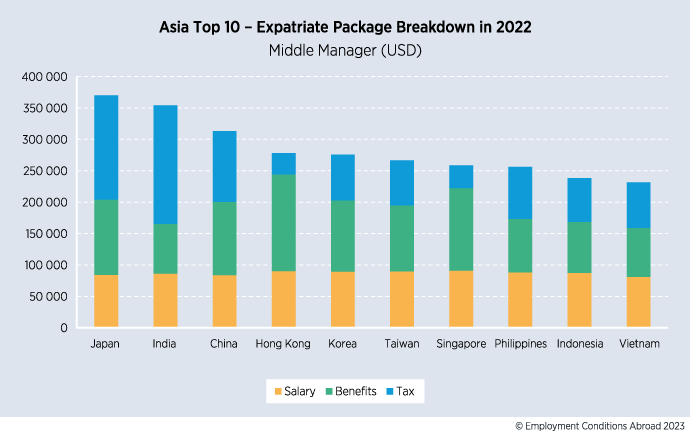According to data survey firm ECA International, expatriate salary and benefits packages in Singapore increased by 4 per cent in 2022 in USD terms, pushing the city-state up six places to 16th in the rankings of the costliest places to employ expatriates globally.
The latest MyExpatriate Market Pay Survey of pay levels for expatriates around the world, including benefits, allowances, salary calculation methods, and tax treatment is published annually by ECA International.
When considering the cost of an expatriate package, companies need to factor in three main elements: the cash salary, benefits – such as accommodation, international schools, utilities, or cars – and tax.
“The surge in the cost of expatriate accommodation in Singapore is being felt by locals and expatriates alike, as reflected in the 9 per cent increase in the cost of benefits in expatriate packages when measured in USD terms,” said Lee Quane, Regional Director, Asia, at ECA International. “Only the fact that salaries fell by USD 4,000 prevented Singapore from moving up the rankings further.”
“Overall, the total salary and benefits packages for expatriates in Singapore rose by 4 per cent to USD 258,762 in 2022,” added Quane.
Expatriate salaries in most locations in the region have fallen this year, said the report, resulting in a drop in the total cost of pay and benefits in more than half of the locations when measured in USD terms. Countries experiencing this decline include Japan, Korea, China, and Taiwan.
The UK remains the most expensive location to send expatriates, with the average expatriate salary and benefits package amounting to USD 441,608 in 2022, which is roughly the same cost as last year. Employee benefits increased 4 per cent to USD 167,594 and are the most expensive in the world, with salary accounting for less than a fifth of the total package.
India ranked third in the world in terms of most expensive pay packages, with a high tax-to-salary ratio package of USD 350,000.
In Asia, Hong Kong is up three places to become the world’s fifth most expensive expatriate pay and benefits package in the world in 2022, despite a 2 per cent decrease compared to 2021. The total value of a typical expatriate package in Hong Kong is now USD 278,020 with salary and benefits costs falling by USD 2,400 and USD 1,600 respectively.
As was the case last year, Malaysia has the lowest salary and benefits package in the region. Total package costs fell by 4 per cent to USD 164,696, with salary costs down 6 per cent.
China retained its position as the location with the third-highest expatriate packages in the region after Japan and India and ranked fourth globally. However, expatriate salaries in China fell by 5 per cent in USD terms in 2022.
In Japan, the salary and benefits packages for expats remained the second most expensive in the world, with a 5 per cent increase in local currency terms. However, due to the weak Japanese yen, the cost of salary, benefits, and taxes all fell by double-digit percentages when measured in USD terms. As a result, the total package is 12 per cent cheaper than last year, costing USD 370,183.
The strength of the US dollar has pushed the US up seven places in the rankings, and into the global top 10. Despite a slight fall in salaries, the total cost of the package has risen by 6 per cent to USD 272,770.
Quane said: "The strong dollar caused the average expatriate salary in the US to fall, as many expats in the country do not receive all of their salary in US dollars. However, higher housing costs contributed to a 10 per cent increase in the cost of benefits, meaning that companies will have found it more expensive to relocate staff to the US in 2022."
Saudi Arabia topped the charts in terms of earnings for expats separated from tax treatments and benefits. The survey found that the highest average salary for middle managers worldwide was USD 108,657 in Saudi Arabia.
The list of countries used in the rankings is based on countries that have cities appearing in the top 40 of The Global Financial Centres Index (GFCI). It draws on data from the United Nations, World Bank, and EIU as well as over 29,000 financial centre assessments from an online questionnaire.





